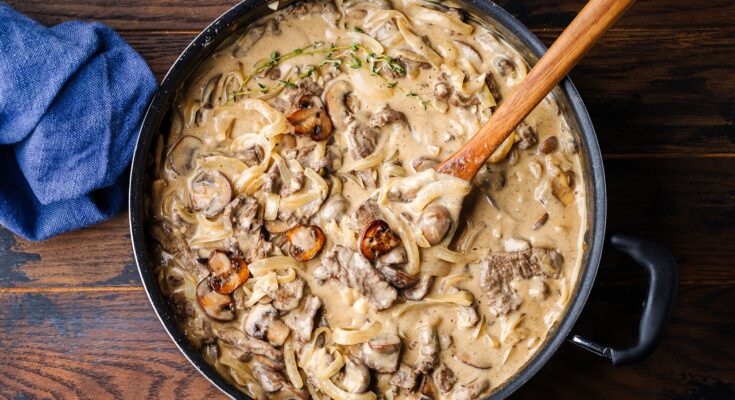Traditional Beef Stroganoff Recipe: There’s something deeply comforting about a dish that’s rich, creamy, and packed with savory flavor.
Traditional Beef Stroganoff hits all the right notes—it’s a Russian-born classic that’s found a cozy place in kitchens around the world. Whether it’s a chilly night or a weekend dinner with loved ones, this hearty meal never disappoints.
In this guide, we’re going to walk you through everything from ingredients to final plating so you can master the art of making this beloved dish from scratch.
Introduction to Beef Stroganoff
Beef Stroganoff has a history as rich as its sauce. Originating in mid-19th century Russia, this dish was supposedly named after Count Pavel Stroganov, a notable aristocrat and general. Initially, it was a simple dish: sautéed beef cubes served in a mustard and sour cream sauce. But as the dish traveled through Europe and eventually to America, it evolved into what we now know and love—a creamy, mushroom-laden delight served over pasta or rice.
So, why does it still capture hearts (and stomachs)? It’s that magical combination of tender beef, silky sour cream sauce, and earthy mushrooms. Not only is it flavorful, but it’s also adaptable. Want to switch up the meat? Go for it. Prefer noodles to rice? Totally fine. The beauty lies in its simplicity and ability to be customized while keeping its comforting core intact.
Ingredients You’ll Need
Before we roll up our sleeves, let’s gather everything we need. Having all ingredients ready will save you time and help everything flow smoothly.
For the Beef:
- 1 lb (450g) beef sirloin or tenderloin, thinly sliced
- Salt and pepper to taste
- 2 tablespoons of all-purpose flour (for coating)
For the Sauce:
- 2 tablespoons olive oil or butter
- 1 large onion, finely chopped
- 2 cloves garlic, minced
- 8 oz (225g) mushrooms, sliced (cremini or white button work great)
- 1 cup beef broth
- 1 tablespoon Dijon mustard
- 1 cup sour cream (full fat for creaminess)
- 1 tablespoon Worcestershire sauce (optional but recommended)
- Salt and pepper, to taste
Optional Add-ons for Extra Flavor:
- Fresh parsley (for garnish)
- Paprika or smoked paprika for added depth
- A splash of white wine for deglazing the pan
Having everything at arm’s reach makes the process way smoother, and you won’t find yourself frantically chopping onions while your beef is burning in the pan!
Best Cuts of Beef for Stroganoff
The beef is the heart of this dish, and choosing the right cut can make or break your Stroganoff. Traditionally, tenderloin or sirloin is used, and for good reason—these cuts cook quickly and stay tender. But let’s be real: they can be a bit pricey. So if you’re cooking on a budget, here are some great alternatives:
- Sirloin Tip – Slightly tougher but works well if sliced thin and not overcooked.
- Ribeye – Super juicy and flavorful, though on the fattier side.
- Flank Steak – Lean and tasty if cooked quickly and sliced against the grain.
- Stewing Beef or Chuck Roast – More affordable but requires longer cooking times (use for a slow cooker version).
The golden rule? Don’t overcook your beef. A quick sear is all it needs; otherwise, it gets chewy and ruins the dish’s signature tenderness.
Preparation Tips Before Cooking
Prepping everything properly before turning on the stove will make your cooking experience easier and your end result better.
Slicing the Beef Correctly
Always slice the beef thinly, about 1/4 inch thick, and against the grain. This means you’re cutting perpendicular to the direction of the muscle fibers. It sounds technical, but it makes a world of difference when it comes to tenderness. If your beef is a bit too soft to slice neatly, pop it in the freezer for 20 minutes—it’ll firm up just enough for cleaner cuts.
Prepping Your Onions and Mushrooms
Chop the onions finely so they cook down evenly and melt into the sauce. For mushrooms, uniform slices are best for even cooking. You want them browned and flavorful, not soggy. Don’t wash mushrooms directly under running water—wipe them clean with a damp paper towel instead to avoid excess moisture.
Getting Your Sauce Ingredients Ready
Measure out your broth, sour cream, mustard, and Worcestershire sauce beforehand. If you’re adding wine, have that ready too. This mise en place approach keeps you from scrambling mid-recipe and ensures you won’t burn anything while fumbling with the spice cabinet.
Step-by-Step Cooking Instructions
Now that we’re all set, let’s fire up the stove and get cooking! Here’s how to bring all those delicious ingredients together into one unforgettable dish.
Step 1: Sear the Beef
- Heat 1 tablespoon of olive oil or butter in a large skillet over medium-high heat.
- Season your sliced beef with salt and pepper, then lightly toss it with flour.
- Once the pan is hot, add the beef in a single layer—do this in batches if necessary. Crowding the pan will steam the meat instead of browning it.
- Sear for 1-2 minutes per side, just until it gets some color. Don’t cook it all the way through—it’ll finish cooking in the sauce.
- Remove the beef and set it aside on a plate.
The key here is high heat and quick cooking. You want that caramelized edge that adds deep flavor to your Stroganoff.
Step 2: Sauté the Onions and Mushrooms
Once your beef is nicely seared and resting on a plate, it’s time to build the flavor base of the dish: onions and mushrooms. This step is crucial because it lays down the earthy, savory flavor that defines a classic Stroganoff.
- In the same skillet, reduce the heat to medium.
- Add a bit more oil or butter if needed.
- Toss in the chopped onions and sauté them until they turn soft and translucent, about 5 minutes.
- Next, add the sliced mushrooms. Don’t overcrowd them—if your pan is small, do this in two batches.
- Let the mushrooms cook undisturbed for a few minutes. This helps them brown and caramelize rather than just release water and steam.
- Once they’re golden, stir occasionally for even cooking. This step should take another 5-7 minutes.
- Add minced garlic during the last 30 seconds of cooking so it doesn’t burn.
At this point, your kitchen will smell heavenly, and you’ll already have the signature aroma of Stroganoff coming to life. Browning the mushrooms properly adds depth and richness to the dish—don’t rush it!
Step 3: Make the Stroganoff Sauce
Now comes the soul of the dish—the creamy, tangy, utterly mouthwatering Stroganoff sauce. It’s a perfect blend of beefy broth, sour cream, and mustard, with a touch of umami from Worcestershire sauce.
- With the onions and mushrooms still in the pan, pour in the beef broth. Use a wooden spoon to scrape up any brown bits from the bottom of the pan (that’s flavor gold!).
- Add 1 tablespoon of Dijon mustard and 1 tablespoon of Worcestershire sauce. Stir to combine.
- Let the mixture simmer for about 5 minutes to reduce slightly and concentrate the flavors.
- Reduce the heat to low and slowly stir in the sour cream. Don’t let the sauce boil after this point, or the sour cream could curdle.
- Stir gently until everything is smooth and well combined. Taste and adjust with salt, pepper, or an extra dash of mustard if you like it tangy.
At this stage, the sauce should be creamy, rich, and silky. If it’s too thick, you can thin it with a splash of broth or milk. If it’s too thin, let it simmer a bit longer until it reduces.
Step 4: Combine and Simmer
With your sauce perfected, it’s time to bring everything together.
- Return the seared beef (and all the juices on the plate) back into the pan.
- Stir gently to coat the meat in the sauce.
- Let the Stroganoff simmer over low heat for 5–10 minutes. This finishes cooking the beef without overdoing it and allows all the flavors to meld beautifully.
- Don’t forget to stir occasionally and keep the heat low—simmering, not boiling.
The beef will absorb the creamy sauce and stay tender, while the flavors become one beautiful, harmonious dish. If you’re adding any extra seasonings like paprika or fresh herbs, now’s the time to sprinkle them in.
Step 5: Serve It Up!
Finally, it’s showtime! You’ve done all the prep, cooking, and simmering—now let’s plate up this comfort food masterpiece.
What to serve it with:
- Egg noodles: The classic option. Their slightly chewy texture is perfect for holding onto the creamy sauce.
- Mashed potatoes: A rich, comforting base that works especially well in colder months.
- Steamed rice: A lighter option that still soaks up all the flavors.
- Buttered crusty bread: Perfect for dipping and sopping up every last drop of sauce.
Garnish suggestions:
- A sprinkle of freshly chopped parsley for color and freshness.
- A dusting of paprika for a smoky kick.
- A dollop of extra sour cream for richness.
Serve it hot, and get ready for the compliments to roll in. This dish is a dinner table winner every single time!
What to Serve with Beef Stroganoff
When it comes to serving Beef Stroganoff, the goal is to find a base that balances and soaks up all that creamy, beefy goodness. Traditionally, egg noodles are the go-to, but don’t be afraid to experiment with other options depending on what you have in the pantry or your personal taste.
Classic Options:
- Egg Noodles: These are the most traditional pairing. Their soft, slightly chewy texture holds the sauce beautifully without overpowering it. Wide egg noodles are particularly great for this.
- Rice: Whether it’s white rice, brown rice, or even wild rice, this is a neutral, fluffy base that allows the rich sauce to shine.
- Mashed Potatoes: This is pure comfort food. Creamy mashed potatoes pair amazingly with Stroganoff for a hearty, stick-to-your-ribs kind of meal.
Creative Alternatives:
- Polenta: Soft, creamy polenta offers a unique texture and makes the dish feel more gourmet.
- Crusty Bread or Garlic Toast: Ideal for a more casual, rustic serving style—perfect for scooping up the sauce.
- Cauliflower Rice or Zoodles (Zucchini Noodles): If you’re looking for a low-carb option, these are excellent substitutes that still provide that sauce-catching base.
The key is to choose something that complements the flavors and texture of the Stroganoff without competing with them. The sauce is the star of the show—so keep the base simple and delicious.
Storage and Reheating Tips
Made a big batch? Great news—Beef Stroganoff is even better the next day. Here’s how to store and reheat it without compromising flavor or texture.
Storing in the Fridge:
- Let the Stroganoff cool completely before storing.
- Place it in an airtight container and refrigerate.
- It will stay fresh for up to 4 days in the fridge.
Reheating Tips:
- Stovetop (Best Option): Reheat gently over medium-low heat, stirring occasionally. If the sauce has thickened too much, add a splash of milk or broth to loosen it up.
- Microwave: Reheat in 30-second bursts, stirring in between to distribute the heat evenly.
- Avoid boiling it again—this could cause the sour cream in the sauce to curdle.
Freezing It:
- Technically, you can freeze Beef Stroganoff, but it comes with a caveat: sauces with sour cream may separate when thawed.
- If you do freeze it, store it in an airtight container and thaw it in the fridge overnight before reheating slowly on the stove.
Tip: If you’re planning to make a freezer batch, consider leaving out the sour cream until you reheat it. Add it fresh while reheating for better texture.
Variations of the Classic Recipe
Beef Stroganoff is one of those recipes that begs to be personalized. Whether you’re accommodating dietary restrictions or just mixing things up, here are some fun and tasty variations.
Protein Variations:
- Chicken Stroganoff: Swap beef for boneless chicken thighs or breasts. Cook it the same way—just reduce the cooking time since chicken cooks quicker.
- Pork Stroganoff: Thin slices of pork tenderloin work wonderfully and offer a slightly different flavor profile.
- Ground Beef Stroganoff: A more budget-friendly and faster version. No need to slice meat—just brown the ground beef, drain the fat, and build your sauce.
Dairy-Free Version:
- Use plant-based sour cream (like cashew cream or coconut yogurt) and dairy-free butter or oil. Make sure your broth is also dairy-free.
Gluten-Free Version:
- Use cornstarch or gluten-free flour to coat the beef.
- Serve over gluten-free pasta, rice, or potatoes.
- Always check that your Worcestershire sauce is gluten-free—some brands contain wheat.
Veggie Variants:
- Add spinach, peas, or bell peppers for color and nutrition.
- Try a mushroom-only Stroganoff for a vegetarian version that still delivers that umami punch.
The versatility of this dish is part of what makes it so universally loved. It adapts to your needs while still staying true to its comforting roots.
Mistakes to Avoid When Making Stroganoff
Even though Beef Stroganoff is pretty straightforward, there are a few common mistakes that can trip you up. Here’s how to avoid them and keep your dish tasting amazing.
1. Overcooking the Beef
The number one mistake! Beef should be just seared—not cooked all the way through in the first step. It finishes cooking in the sauce. Overcooked beef becomes tough and chewy.
2. Boiling the Sour Cream
Sour cream should be stirred in off the heat or over very low heat. Boiling it causes curdling, which ruins the smooth texture of the sauce.
3. Using Low-Quality Broth
Your broth adds depth to the sauce. Use a high-quality beef broth—or better yet, homemade. It makes a massive difference in flavor.
4. Skipping the Browning Step
Browning the beef and mushrooms builds flavor. Don’t skip this or crowd the pan. A proper sear is crucial.
5. Adding Too Much Flour
Coating the beef in flour is fine, but too much can thicken the sauce too aggressively or give it a paste-like consistency. A light dusting is all you need.
By steering clear of these pitfalls, you’re well on your way to Stroganoff perfection every time.
Healthier Alternatives Without Losing Flavor
Looking to enjoy Stroganoff without the guilt? You totally can. With a few smart swaps, you can make a lighter version that still tastes indulgent.
Lighter Dairy Options:
- Use Greek yogurt instead of sour cream—it’s tangy, high in protein, and much lower in fat.
- Opt for light sour cream or light cream cheese as a healthier alternative.
Low-Fat Cooking Techniques:
- Sear the beef in olive oil spray instead of butter.
- Skip the flour coating and just season the beef before searing.
Veggie Boosts:
- Add mushrooms, zucchini, spinach, or even grated carrots to increase the nutrient density.
- Serve over cauliflower rice or whole wheat pasta for more fiber and fewer carbs.
You can easily shave off calories and fat while keeping all the richness and flavor. Healthy Stroganoff doesn’t have to taste like diet food!
FAQs about Traditional Beef Stroganoff Recipe
What is Beef Stroganoff?
Beef Stroganoff is a classic Russian dish that features thin slices of beef cooked in a creamy sauce with mushrooms and onions. Typically served over noodles or rice, this dish is known for its rich flavors and comforting, hearty texture.
What type of beef is best for Beef Stroganoff?
For the most tender and flavorful Beef Stroganoff, it’s best to use cuts like sirloin or tenderloin. These cuts cook quickly and stay succulent, making them perfect for the quick sautéing process essential to this dish.
Can I use chicken or pork instead of beef?
Absolutely! While beef is traditional, chicken or pork can be used as substitutes. Just keep the cooking times in check, as these meats may cook quicker or require more seasoning to match the robust flavor of beef.
What mushrooms are best for Beef Stroganoff?
Classic Beef Stroganoff typically uses button mushrooms, but for a deeper flavor, you can experiment with cremini or even a mix of wild mushrooms. The key is to use fresh mushrooms for the best texture and taste.
Is there a dairy-free alternative for the creamy sauce?
Yes, for those avoiding dairy, you can use plant-based creams such as coconut cream or almond cream. These alternatives lend a similar richness and texture to the sauce without using dairy.
How do I prevent the sour cream from curdling?
To prevent curdling, ensure your sour cream is at room temperature before adding it to the pan. Also, stir it in off the heat and let the residual warmth gently incorporate the sour cream into the sauce.
What are some traditional sides to serve with Beef Stroganoff?
Beef Stroganoff is commonly served over egg noodles, but you can also serve it with rice or mashed potatoes. For a lighter option, opt for a crisp green salad.
Can Beef Stroganoff be made in advance?
Yes, Beef Stroganoff can be prepared in advance and gently reheated, making it a convenient option for meal prepping. Just be cautious when reheating to avoid overheating the sauce, which can cause the dairy components to separate.
Final Thoughts
Remember, the key to nailing this dish lies in the little details—choosing the right cut of beef, not overcooking it, letting your mushrooms brown properly, and gently incorporating the sour cream to maintain that luscious texture.
So go ahead, tie on your apron, and give this recipe a try. One bite in, and you’ll see why it’s been a global favorite for decades. Happy cooking!



